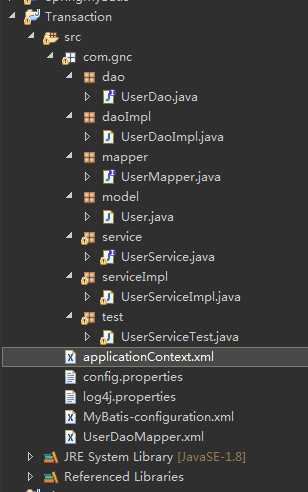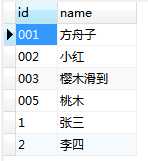标签:expr class 隔离 div doc initial 相同 sel 好的
前几篇的文章都只是初步学习spring和mybatis框架,所写的实例也都非常简单,所进行的数据访问控制也都很简单,没有加入事务管理.这篇文章将初步接触事务管理.
1.事务管理
理解事务管理之前,先通过一个例子讲一下什么是事务管理:取钱。
比如你去ATM机取1000块钱,大体有两个步骤:首先输入密码金额,银行卡扣掉1000元钱;然后ATM出1000元钱。这两个步骤必须是要么都执行要么都不执行。如果银行卡扣除了1000块但是ATM出钱失败的话,你将会损失1000元;如果银行卡扣钱失败但是ATM却出了1000块,那么银行将损失1000元。所以,如果一个步骤成功另一个步骤失败对双方都不是好事,如果不管哪一个步骤失败了以后,整个取钱过程都能回滚,也就是完全取消所有操作的话,这对双方都是极好的。 事务就是用来解决类似问题的。事务是一系列的动作,它们综合在一起才是一个完整的工作单元,这些动作必须全部完成,如果有一个失败的话,那么事务就会回滚到最开始的状态,仿佛什么都没发生过一样。 在企业级应用程序开发中,事务管理必不可少的技术,用来确保数据的完整性和一致性。
事务有四个特性:ACID
2.小实例工程
(1)工程目录:

(2)建立数据库transaction,建立一张user表:

(3)建立User.java类:
package com.gnc.model; public class User { private String id; private String name; public String getId() { return id; } public void setId(String id) { this.id = id; } public String getName() { return name; } public void setName(String name) { this.name = name; } public User() { } public User(String id, String name) { super(); this.id = id; this.name = name; } }
(4)建立UserDao.java数据访问接口:
package com.gnc.dao; import java.util.List; import java.util.Map; import com.gnc.model.User; public interface UserDao { public int countAll(); public void insertUser(User user); public List<User> getAllUser(); public User getById(String id); public void deleteUser(String id); public void updateUser(Map<String,Object> map); }
(5)建立实现UserDaoImpl.java类:
package com.gnc.daoImpl; import java.util.List; import java.util.Map; import org.springframework.beans.factory.annotation.Autowired; import org.springframework.stereotype.Service; import com.gnc.dao.UserDao; import com.gnc.mapper.UserMapper; import com.gnc.model.User; @Service("userDao") public class UserDaoImpl implements UserDao { @Autowired private UserMapper userMapper; public int countAll() { return this.userMapper.countAll(); } @Override public void insertUser(User user) { this.userMapper.insertUser(user); } @Override public List<User> getAllUser() { return this.userMapper.getAllUser(); } @Override public User getById(String id) { return this.userMapper.getById(id); } @Override public void deleteUser(String id) { this.userMapper.deleteUser(id); } @Override public void updateUser(Map<String, Object> map) { this.userMapper.updateUser(map); } }
(6)建立UserDao接口访问映射文件UserDaoMapper.xml:
<?xml version="1.0" encoding="UTF-8" ?> <!DOCTYPE mapper PUBLIC "-//mybatis.org//DTD Mapper 3.0//EN" "http://mybatis.org/dtd/mybatis-3-mapper.dtd"> <mapper namespace="com.gnc.mapper.UserMapper"> <parameterMap id="parameterMapUser" type="com.gnc.model.User" > <parameter property="id" /> <parameter property="name" /> </parameterMap> <resultMap id="resultMapUser" type="com.gnc.model.User" > <result property="id" column="id" /> <result property="name" column="name" /> </resultMap> <insert id="insertUser" parameterMap="parameterMapUser"> INSERT INTO user(id,name) VALUES(?,?) </insert> <select id="countAll" resultType="int"> select count(*) c from user; </select> <select id="getAllUser" resultMap="resultMapUser"> SELECT * FROM user </select> <select id="getById" parameterType="String" resultMap="resultMapUser"> SELECT * FROM user WHERE id=#{value} </select> <delete id="deleteUser" parameterType="String"> DELETE FROM user WHERE id=#{value} </delete> <update id="updateUser" parameterType="java.util.Map"> UPDATE user SET name=#{name} WHERE id=#{id} </update> </mapper>
(7)建立UserService.java接口类:
package com.gnc.service; import java.util.Map; import com.gnc.model.User; public interface UserService { public int countAll(); public void insertUser(User user); public void update_insert(Map map, User user); }
(8)建立UserServiceImpl.java实现类:
package com.gnc.serviceImpl; import java.util.Map; import org.springframework.beans.factory.annotation.Autowired; import org.springframework.stereotype.Service; import com.gnc.dao.UserDao; import com.gnc.model.User; import com.gnc.service.UserService; @Service("userService") public class UserServiceImpl implements UserService { @Autowired private UserDao userDao; public int countAll() { return this.userDao.countAll(); } @Override public void insertUser(User user) { this.userDao.insertUser(user); throw new RuntimeException("Error"); } @Override public void update_insert(Map map, User user) { this.userDao.updateUser(map); this.userDao.insertUser(user); throw new RuntimeException("Error"); } }
(9)建立mybatis配置文件MyBatis-Configuration.xml:
<?xml version="1.0" encoding="UTF-8" ?> <!DOCTYPE configuration PUBLIC "-//mybatis.org//DTD Config 3.0//EN" "http://mybatis.org/dtd/mybatis-3-config.dtd"> <configuration> <mappers> <mapper resource="UserDaoMapper.xml"/> </mappers> </configuration>
(10)建立数据库配置文件config.properties:
db.driverClass=org.gjt.mm.mysql.Driver
db.jdbcUrl=jdbc:mysql://localhost:3306/transaction
db.user=root
db.password=geningchao
#
db.initialPoolSize=20
db.maxIdleTime=60
db.maxPoolSize=200
db.minPoolSize=50
#
db.acquireIncrement=3
db.acquireRetryDelay=1000
db.acquireRetryAttempts=30
db.breakAfterAcquireFailure=false
(11)建立spring配置文件applicationContext.xml:
<?xml version="1.0" encoding="UTF-8"?> <beans xmlns="http://www.springframework.org/schema/beans" xmlns:xsi="http://www.w3.org/2001/XMLSchema-instance" xmlns:context="http://www.springframework.org/schema/context" xmlns:tx="http://www.springframework.org/schema/tx" xmlns:aop="http://www.springframework.org/schema/aop" xmlns:mvc="http://www.springframework.org/schema/mvc" xsi:schemaLocation=" http://www.springframework.org/schema/beans http://www.springframework.org/schema/beans/spring-beans-3.0.xsd http://www.springframework.org/schema/context http://www.springframework.org/schema/context/spring-context-3.0.xsd http://www.springframework.org/schema/tx http://www.springframework.org/schema/tx/spring-tx.xsd http://www.springframework.org/schema/aop http://www.springframework.org/schema/aop/spring-aop-3.0.xsd http://www.springframework.org/schema/mvc http://www.springframework.org/schema/mvc/spring-mvc-3.0.xsd"> <!-- 加载配置文件 --> <context:property-placeholder location="config.properties" /> <!-- 指定spring注解注入层 --> <context:component-scan base-package="com.gnc" /> <!-- 数据库连接池管理 --> <bean id="c3p0DataSource" class="com.mchange.v2.c3p0.ComboPooledDataSource" destroy-method="close"> <property name="driverClass" value="${db.driverClass}"></property> <property name="jdbcUrl" value="${db.jdbcUrl}"></property> <property name="user" value="${db.user}"></property> <property name="password" value="${db.password}"></property> <property name="initialPoolSize" value="${db.initialPoolSize}"></property> <!--最大空闲时间,60秒内未使用则连接被丢弃。若为0则永不丢弃。Default: 0 --> <property name="maxIdleTime" value="${db.maxIdleTime}"></property> <!--连接池中保留的最大连接数。Default: 15 --> <property name="maxPoolSize" value="${db.maxPoolSize}"></property> <property name="minPoolSize" value="${db.minPoolSize}"></property> <!--当连接池中的连接耗尽的时候c3p0一次同时获取的连接数。Default: 3 --> <property name="acquireIncrement" value="${db.acquireIncrement}"></property> <!--两次连接中间隔时间,单位毫秒。Default: 1000 --> <property name="acquireRetryDelay" value="${db.acquireRetryDelay}"></property> <!--定义在从数据库获取新连接失败后重复尝试的次数。Default: 30 --> <property name="acquireRetryAttempts" value="${db.acquireRetryAttempts}"></property> <!--获取连接失败将会引起所有等待连接池来获取连接的线程抛出异常。但是数据源仍有效保留,并在下次调用getConnection()的时候继续尝试获取连接。如果设为true,那么在尝试 获取连接失败后该数据源将申明已断开并永久关闭。Default: false --> <property name="breakAfterAcquireFailure" value="${db.breakAfterAcquireFailure}"></property> </bean> <!-- ================================事务相关控制================================================= --> <bean name="transactionManager" class="org.springframework.jdbc.datasource.DataSourceTransactionManager"> <property name="dataSource" ref="c3p0DataSource"></property> </bean> <tx:advice id="userTxAdvice" transaction-manager="transactionManager"> <tx:attributes> <tx:method name="delete*" propagation="REQUIRED" read-only="false" rollback-for="java.lang.Exception" no-rollback-for="java.lang.RuntimeException" /> <tx:method name="insert*" propagation="REQUIRED" read-only="false" rollback-for="java.lang.RuntimeException" /> <tx:method name="update*" propagation="REQUIRED" read-only="false" rollback-for="java.lang.Exception" /> <tx:method name="find*" propagation="SUPPORTS" /> <tx:method name="get*" propagation="SUPPORTS" /> <tx:method name="select*" propagation="SUPPORTS" /> </tx:attributes> </tx:advice> <aop:config> <aop:pointcut id="pc" expression="execution(public * com.gnc.service.*.*(..))" /> <!--把事务控制在Service层 --> <aop:advisor pointcut-ref="pc" advice-ref="userTxAdvice" /> </aop:config> <bean id="sqlSessionFactory" class="org.mybatis.spring.SqlSessionFactoryBean"> <property name="dataSource" ref="c3p0DataSource" /> <property name="configLocation" value="MyBatis-Configuration.xml" /> </bean> <bean class="org.mybatis.spring.mapper.MapperFactoryBean"> <property name="mapperInterface" value="com.gnc.mapper.UserMapper" /> <property name="sqlSessionFactory" ref="sqlSessionFactory" /> </bean> </beans>
(12)建立测试类UserServiceTest.java:
package com.gnc.test;
import java.util.HashMap;
import java.util.Map;
import org.junit.Test;
import org.springframework.context.ApplicationContext;
import org.springframework.context.support.ClassPathXmlApplicationContext;
import com.gnc.model.User;
import com.gnc.service.UserService;
public class UserServiceTest {
@Test
public void userServiceTest(){
@SuppressWarnings("resource")
ApplicationContext context = new ClassPathXmlApplicationContext("applicationContext.xml");
UserService userService = (UserService)context.getBean("userService");
User user =new User();
user.setId("003");
user.setName("樱木花道");
Map map=new HashMap();
map.put("id", "001");
map.put("name", "方舟子");
try {
System.out.println(userService.countAll());
userService.update_insert(map, user);
} catch (Exception e) {
e.printStackTrace();
}
}
}
3.工程分析
该工程属于声明式事务管理,事务管理的主要配置是写在spring的配置文件当中,工程运行时,先加载spring配置文件,通过spring配置文件得到mybatis配置文件,得到映射文件,进行事务处理以及书屋管理.但是这种事务管理方式限制了包的分级结构和函数名的前缀,所以一般情况下,我们使用注解式事务管理,注解式事务管理实例将在下一章节给出并进行说明!
以上仅是个人观点,若有不对,敬请扶正!
标签:expr class 隔离 div doc initial 相同 sel 好的
原文地址:http://www.cnblogs.com/geningchao/p/6628452.html